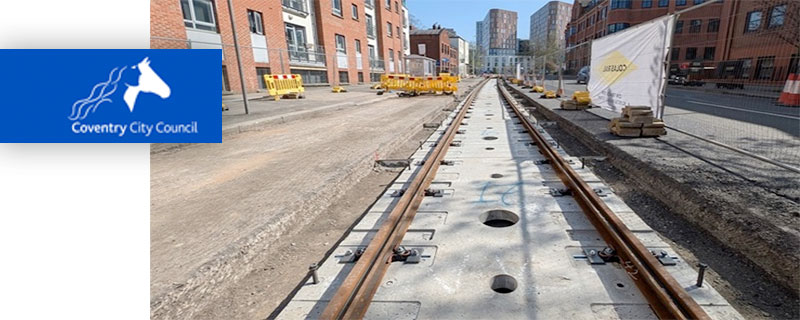The Future of Urban Mobility
The Coventry Very Light Rail (CVLR) project has achieved a significant technical milestone with the construction of a 220-metre single-track demonstrator in the city’s heart.
Installed along Greyfriars Road and Queen Victoria Road, this trial represents the first time CVLR’s innovative modular track form has been embedded within a live urban corridor.
The 50 %+ completion milestone follows the appointment of the Principal Contractor in mid-February 2025. Delivery has progressed swiftly to the completion of laying and aligning all Ultra-High-Performance Concrete (UHPC) slabs and the alignment, welding, and fastening of the grooved rails. With full slab bedding now also complete, the result is a structurally sound and installation-complete track form, ready to accept the CVLR vehicle.
Over the coming weeks, the team will finalise the installation of the structural health monitoring system, rail drainage, and rail-to-pavement interface components before embedding rails in asphalt pavement. The team targets completion of the construction phase by early May 2025.
Dr Christopher Micallef, CVLR track programme lead at Coventry City Council, said: “This milestone represents a step-change in the technology readiness level of the novel CVLR track system. Having progressed through concept design, laboratory testing, and a series of increasingly complex pilot installations in controlled environments, we are now proving the system in a dense, operational urban corridor for the first time.”
Councillor Jim O’Boyle, Cabinet Member for Jobs, Regeneration, and Climate Change at Coventry City Council, said: “This is a significant step forward for the CVLR project and how cities like Coventry can rethink public transport infrastructure. We are not just piloting technology, we are building confidence in a scalable model that puts climate, community, and cost-effectiveness at the heart of urban mobility. And I’m pleased to say that this innovation has been born out of our manufacturing skills in this city and the wider region. The green economy is growing, and CVLR is at the heart of that here.”
A Technically Complex Urban Demonstrator
The track alignment was chosen to test real-world challenges typical of dense city centres. It traverses a longitudinal gradient between 1.5% and 3.5%, incorporates a 30-metre radius curve, and applies a continuous cant to facilitate compatibility with existing road geometry.
Construction was undertaken within a strictly constrained corridor, maintaining continuous access across an active junction. Crucially, no full road closures or traffic diversions were required — a key goal in demonstrating CVLR’s ‘LITE footprint’ on the public realm.
The route also interfaces with all primary below-ground services, including water (clean and foul), gas, electricity, and telecommunications. The track form’s shallow 300mm excavation depth and integrated utility access chambers enabled installation without major service relocation — a fundamental advantage over traditional tram systems.
Iain Anderson, Managing Director, Colas Rail UK, said: “This trial installation demonstrates how innovative rail infrastructure can be delivered in real city environments with minimal disruption. Our teams worked closely with Coventry City Council to adapt to complex site conditions in real time, showing what’s possible when engineering meets digital responsiveness.”
Enabling a Step Change in Light Rail Construction
CVLR’s approach is underpinned by enabling technologies to overcome the traditional barriers to light rail deployment in the UK. These include:
- The use of UHPC slabs as the core structural element — offering exceptional strength at approximately 100 mm thickness. This enables the construction of the track superstructure without requiring the typical concrete foundation.
- A digitally integrated construction platform that ensures rapid design adaptation and data capture.
- A live structural health monitoring system, embedded into the infrastructure, to validate long-term performance in real-world conditions.
Together, these technologies enable a radically simplified, utility-friendly track form that is scalable and repeatable across various urban contexts.
Real-Time Monitoring for Long-Term Insights
The track section has a state-of-the-art, high-frequency structural health monitoring system. This includes strain gauges embedded within the UHPC slabs, asphalt strain gauges, accelerometers, pressure sensors, relative movement sensors, and AI-enabled camera systems.
This system enables engineers to study the infrastructure’s behaviour under ambient conditions, CVLR vehicle loads, and general road traffic over the short and long term. The data will feed into a digital twin of the track form, allowing predictive modelling, lifecycle assessment, and future specification refinement.
Digital Construction: Adaptable and Transparent
Another innovation showcased in this phase is using a digital construction management platform, which enables real-time communication of on-site as-built survey data directly to the design team. This capability has proven essential during milling operations, where conditions such as out-of-spec shallow utilities and historic cobblestone layers require fast redesign and decision-making.
The platform also generates a high-resolution, fully traceable record of the as-built infrastructure, which can be accessed using augmented reality technologies. This significantly enhances transparency, quality assurance, and long-term asset management.
Looking Ahead
Following the completion of construction on the test track, the CVLR vehicle will be brought into Coventry city centre to commence a period of public engagement and trial running on the newly installed infrastructure. These demonstrations will allow stakeholders and the public to experience the system first-hand and provide valuable feedback to inform future development.
Once the trial runs conclude, the site will be returned to regular highway use, but it will continue to serve as a long-term testbed. Regular road traffic will contribute live loading to the track form, providing essential data to validate the system’s performance over time. This ongoing monitoring is critical to demonstrating the durability and lifecycle behaviour of the CVLR track form under mixed-use conditions.
The programme will then progress towards delivering the first integrated transport system utilising the CVLR infrastructure, which will be part of the following primary phase. This work is being delivered as part of a dedicated research and development programme fully funded by the Department for Transport (DfT) through the West Midlands Combined Authority (WMCA) to create a scalable and sustainable urban mobility solution for the future.
Source: Coventry City Council









Leave a Reply
Want to join the discussion?Feel free to contribute!